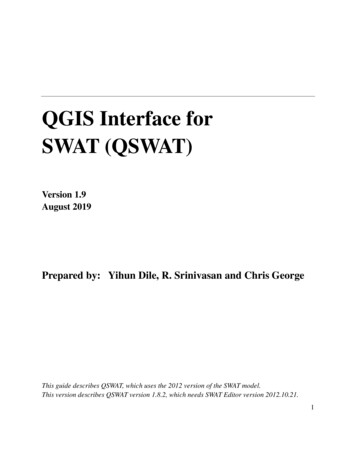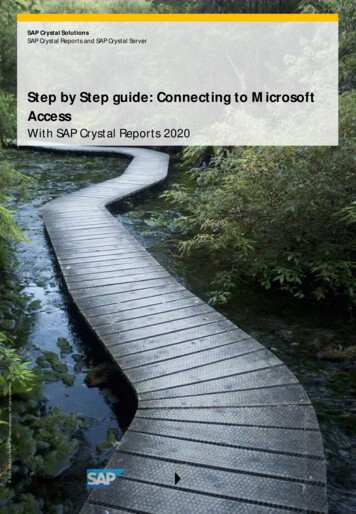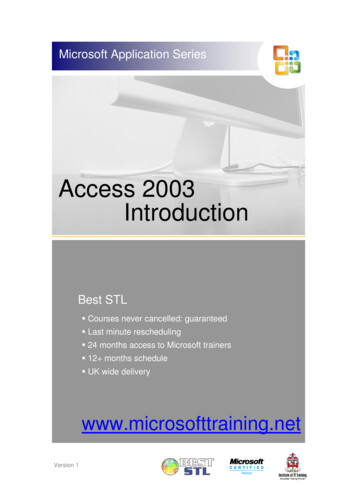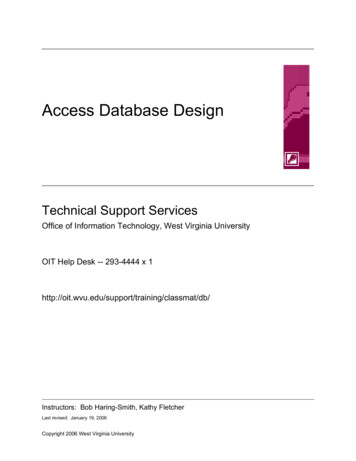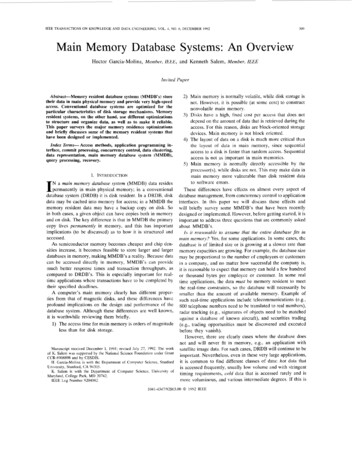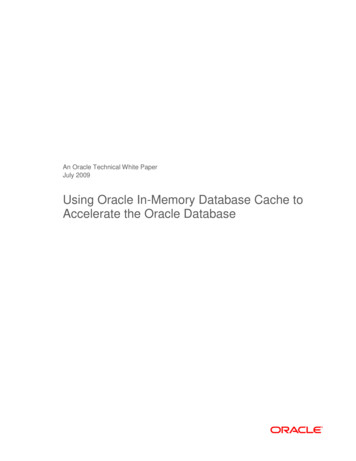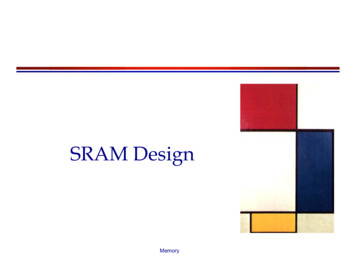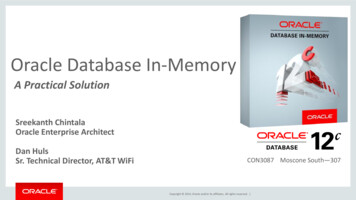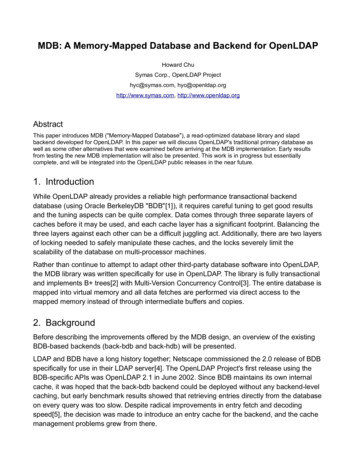
Transcription
MDB: A Memory-Mapped Database and Backend for OpenLDAPHoward ChuSymas Corp., OpenLDAP Projecthyc@symas.com, hyc@openldap.orghttp://www.symas.com, http://www.openldap.orgAbstractThis paper introduces MDB ("Memory-Mapped Database"), a read-optimized database library and slapdbackend developed for OpenLDAP. In this paper we will discuss OpenLDAP's traditional primary database aswell as some other alternatives that were examined before arriving at the MDB implementation. Early resultsfrom testing the new MDB implementation will also be presented. This work is in progress but essentiallycomplete, and will be integrated into the OpenLDAP public releases in the near future.1. IntroductionWhile OpenLDAP already provides a reliable high performance transactional backenddatabase (using Oracle BerkeleyDB "BDB"[1]), it requires careful tuning to get good resultsand the tuning aspects can be quite complex. Data comes through three separate layers ofcaches before it may be used, and each cache layer has a significant footprint. Balancing thethree layers against each other can be a difficult juggling act. Additionally, there are two layersof locking needed to safely manipulate these caches, and the locks severely limit thescalability of the database on multi-processor machines.Rather than continue to attempt to adapt other third-party database software into OpenLDAP,the MDB library was written specifically for use in OpenLDAP. The library is fully transactionaland implements B trees[2] with Multi-Version Concurrency Control[3]. The entire database ismapped into virtual memory and all data fetches are performed via direct access to themapped memory instead of through intermediate buffers and copies.2. BackgroundBefore describing the improvements offered by the MDB design, an overview of the existingBDB-based backends (back-bdb and back-hdb) will be presented.LDAP and BDB have a long history together; Netscape commissioned the 2.0 release of BDBspecifically for use in their LDAP server[4]. The OpenLDAP Project's first release using theBDB-specific APIs was OpenLDAP 2.1 in June 2002. Since BDB maintains its own internalcache, it was hoped that the back-bdb backend could be deployed without any backend-levelcaching, but early benchmark results showed that retrieving entries directly from the databaseon every query was too slow. Despite radical improvements in entry fetch and decodingspeed[5], the decision was made to introduce an entry cache for the backend, and the cachemanagement problems grew from there.
These problems include: Multiple caches that each need to be carefully configured. On top of the BDB cache,there are caches for entries, DNs, and attribute indexing in the backend. All of thesewaste memory since the same data may be present in three places - the filesystemcache, the BDB cache, and the backend caches. Configuration is a tedious jobbecause each cache layer has different size and speed characteristics and it is difficultto strike a balance that is optimal for all use cases. Caches with very complex lock dependencies. For speed, most of the backend cachesare protected by simple mutexes. However, when interacting with the BDB API, thesemutexes must be dropped and exchanged for (much slower) database locks.Otherwise deadlocks which could not be detected by BDB's deadlock detector mayoccur. Deadlocks occur very frequently in routine operation of the backend. Caches with pathological behavior if they were smaller than the whole database. Whenthe cache size was small enough that a significant number of queries were not beingsatisfied from the cache, extreme heap fragmentation was observed[6], as the cachefreed existing entries to make room for new entries. The fragmentation would causethe size of the slapd process to rapidly grow, defeating the purpose of setting a smallcache size. The problem was worst with the memory allocator in GNU libc[7], andcould be mitigated by using alternatives such as Hoard[8] or Google tcmalloc[9], butadditional changes were made in slapd to reduce the number of calls to malloc() andfree() to delay the onset of this fragmentation issue[10]. Caches with very low effectiveness. When multiple queries arrive whose result sets arelarger than the entry cache, the cache effectiveness drops to zero because entries areconstantly being freed before they ever get any chance of being re-used[11]. A greatdeal of effort was expended exploring more advanced cache replacement algorithms tocombat this problem[12][13].From the advent of the back-bdb backend until the present time, the majority of developmentand debugging effort in these backends has all been devoted to backend cache management.The present state of affairs is difficult to configure, difficult to optimize, and extremely laborintensive to maintain.Another issue relates to administrative overhead in general. For example, BDB uses writeahead logs for its transaction support. These logs are written before database updates areperformed, so that in case an update is interrupted or aborted, sufficient information is presentto undo the updates and return the database to the state it was in before the update began.The log files grow continuously as updates are made to a database, and can only be removedafter an expensive checkpoint operation is performed. Later versions of BDB added an autoremove option to delete old log files automatically, but if the system crashed while this optionwas in use, generally the database could not be recovered successfully because thenecessary logs had been deleted.
3. SolutionsThe problems with back-bdb and back-hdb can be summed up in two main areas: cachemanagement, and lock management. The approach to a solution with back-mdb is simple - dono caching, and do no locking. The other issues of administrative overhead are handled asside-effects of the main solutions.3.1Eliminating CachingOne fundamental concept behind the MDB approach is known as "Single-Level Store"[14].The basic idea is to treat all of computer memory as a single address space. Pages ofstorage may reside in primary storage (RAM) or in secondary storage (disk) but the actuallocation is unimportant to the application. If a referenced page is currently in primary storagethe application can use it immediately, if not a page fault occurs and the operating systembrings the page into primary storage. The concept was introduced in 1964 in the Multics[15]operating system but was generally abandoned by the early 1990s as data volumessurpassed the capacity of 32 bit address spaces. (We last knew of it in the ApolloDOMAIN[16] operating system, though many other Multics-influenced designs carried it on.)With the ubiquity of 64 bit processors today this concept can again be put to good use. (Givena virtual address space limit of 63 bits that puts the upper bound of database size at 8exabytes. Commonly available processors today only implement 48 bit address spaces,limiting us to 47 bits or 128 terabytes.)Another operating system requirement for this approach to be viable is a Unified BufferCache. While most POSIX-based operating systems have supported an mmap() system callfor many years, their initial implementations kept memory managed by the VM subsystemseparate from memory managed by the filesystem cache. This was not only wasteful (again,keeping data cached in two places at once) but also led to coherency problems - datamodified through a memory map was not visible using filesystem read() calls, or data modifiedthrough a filesystem write() was not visible in the memory map. Most modern operatingsystems now have filesystem and VM paging unified, so this should not be a concern in mostdeployments[17][18][19].The MDB library is designed to access an entire database thru a single read-only memorymap. Keeping the mapping read-only prevents stray writes from buggy application code fromcorrupting the database. Updates are performed using regular write() calls. (Updating throughthe map would be difficult anyway since files cannot be grown through map references; onlyupdates to existing pages could be done through the map. For simplicity all updates are doneusing write() and it doesn't matter whether the update grows the file or not.) This updateapproach requires that the filesystem and VM views are kept coherent, thus the requirementthat the OS uses a Unified Buffer Cache.The memory-mapped approach makes full use of the operating system's filesystem cache,and eliminates any database-level caching. Likewise the back-mdb backend performs nocaching of its own; it uses information from the database directly. Using the memory-mapped
data thus eliminates two levels of caching relative to back-hdb, as well as eliminatingredundant memcpy() operations between those caches. It also eliminates all cachetuning/configuration issues, thus easing deployment for administrators.Of course, by eliminating caching, one would expect to incur a significant performance hit. Itshould be much faster to dump out the contents of a cached, fully decoded entry in responseto a search request, than to read the entry in from disk and decode it on every request. Earlyresults with back-mdb showed this to be true, but further optimization in back-mdb has mostlyeliminated this performance hit.3.2Eliminating LockingThe other fundamental concept behind MDB is the use of Multi-Version Concurrency Control(MVCC). The basic idea is that updates of data never overwrite existing data; instead theupdates write to new pages and thus create a new version of the database. Readers onlyever see the snapshot of the database as it existed when a read transaction began, so theyare fully isolated from writers. Because of this isolation read accesses require no locks, theyalways have a self-consistent view of the database.BDB has supported MVCC since version 4.5.20, but because of the caching layer in backbdb/hdb there was no benefit to using it. The only way to get any gain from using MVCC wasto also eliminate the backend caching layer, and without the caching layer back-bdb/hdb'sperformance would be too slow because data lookups in BDB were still too slow.A major downside of MVCC-based systems is that since they always write new data to newdisk pages, the database files tend to grow without bound. They need periodic compaction orgarbage collection in order to keep their disk usage constrained, and the required frequencyof such compaction efforts is very high on databases with high update rates. Additionally,systems based on garbage collection generally require twice as much disk space as theactual data occupies. Also, in order to sustain a write rate of N operations/second, the I/Osystem must actually support 2N operations/second, since the compaction task needs torun faster than the normal write task in order to catch up and actually complete its job, and thevolume of data already written always exceeds the volume being written. If this overprovisioning of I/O resources cannot be guaranteed, then the typical solution to this problemis to deny updates while compaction is being performed.Causing a service outage for writes while garbage collection is performed is unacceptable, soMDB uses a different approach. Within a given MDB database environment, MDB maintainstwo B tree structures - one containing application data, and another one containing a free listwith the IDs of pages that are no longer in use. Tracking the in-use status is typically donewith reference counters and other such mechanisms that require locking. Obviously the use oflocking would defeat the purpose of using MVCC in the first place, so a lockless solution wasdesigned instead. With this solution, pages that are no longer in use by any active snapshotof the database are re-used by updaters, so the database size remains relatively static. Thisis a key advantage of MDB over other well-known MVCC databases such as CouchDB[20].
4. Implementation HighlightsSince all of the source code has been publicly available from the outset, and due to spacelimitations in this paper, only a few of the most notable implementation details will bedescribed here. Interested parties are invited to read the code in the OpenLDAP git repositoryand post questions on the openldap-technical mailing list.The MDB library API was loosely modeled after the BDB API, to ease migration of BDB-basedcode. The first cut of the back-mdb code was simply copied from the back-bdb source tree,and then all references to the caching layers were deleted. After a few minor API differenceswere accounted for, the backend was fully operational (though still in need of optimization). Asof today back-mdb comprises 340KB of source code, compared to 476KB for back-bdb/hdb,so back-mdb is approximately 30% smaller.The MDB code itself started from Martin Hedenfalk's append-only Btree code in the OpenBSDldapd source repository[21]. The first cut of the MDB code was simply copied from the ldapdsource, and then all of the Btree page cache manager was deleted and replaced with mmapaccesses. The original Btree source yielded an object file of 39KB; the MDB version was32KB. Initial testing with the append-only code proved that approach to be completelyimpractical. With a small test database and only a few hundred add/delete operations, the DBoccupied 1027 pages but only 10 pages actually contained current data; over 99% of thespace was wasted.Along with the mmap management and page reclamation, many other significant changeswere made to arrive at the current MDB library, mostly to add features from BDB that backmdb would need. As of today the MDB library comprises 35KB of object code. (Comparingsource code is not very informative since the MDB source code has been heavily expandedwith Doxygen comments. The initial version of mdb.c was 59KB as opposed to btree.c at76KB but with full documentation embedded mdb.c is now 162KB. Also for comparison, BDBis now over 1.5MB of object code.)4.1MDB Change SummaryThe append-only Btree code used a meta page at the end of the database file to point at thecurrent root node of the Btree. New pages were always written out sequentially at the end ofthe file, followed by a new meta page upon transaction commit. Any application opening thedatabase needed to search backward from the end of the file to find the most recent metapage, to get a current snapshot of the database. (Further explanation of append-onlyoperation is available at Martin's web site[22].)In MDB there are two meta pages occupying page 0 and page 1 of the file. They are usedalternately by transactions. Each meta page points to the root node of two Btrees - one for thefree list and one for the application data. New data first re-uses any available pages from thefree list, then writes sequentially at the end of the file if no free pages are available. Then theolder meta page is written on transaction commit. This is nothing more than standard doublebuffering - any application opening the database uses the newer meta page, while a
committer overwrites the older one. No locks are needed to protect readers from writers;readers are guaranteed to always see a valid root node.The original code only supported a single Btree in a given database file. For MDB we wantedto support multiple trees in a single database file. The back-mdb indexing code usesindividual databases for each attribute index, and it would be a non-starter to require asysadmin to configure multiple mmap regions for a single back-mdb instance. Additionally, theindexing code uses BDB's sorted duplicate feature, which allows multiple data items with thesame key to be stored in a Btree, and this feature needed to be added to MDB as well. Thesefeatures were both added using a subdatabase mechanism, which allows a data item in aBtree to be treated as the root node of another Btree.4.2LockingFor simplicity the MDB library allows only one writer at a time. Creating a write transactionacquires a lock on a writer mutex; the mutex normally resides in a shared memory region sothat it can be shared between multiple processes. This shared memory is separate from theregion occupied by the main database. The lock region also contains a table with one slot forevery active reader in the database. The slots record the reader's process and thread ID, aswell as the ID of the transaction snapshot the reader is using. (The process and thread ID arerecorded to allow detection of stale entries in the table, e.g. threads that exited withoutreleasing their reader slot.) The table is constructed in processor cache-aligned memory suchthat False Sharing[23] of cache lines is avoided.Readers acquire a slot the first time a thread opens a read transaction. Acquiring an emptyslot in the table requires locking a mutex on the table. The slot address is saved in threadlocal storage and re-used the next time the thread opens a read transaction, so the threadnever needs to touch the table mutex ever again. The reader stores its transaction ID in theslot at the start of the read transaction and zeroes the ID in the slot at the end of thetransaction. In normal operation, there is nothing that can block the operation of readers.The reader table is used when a writer wants to allocate a page, and knows that the free list isnot empty. Writes are performed using copy-on-write semantics; whenever a page is to bewritten, a copy is made and the copy is modified instead of the original. Once copied, theoriginal page's ID is added to an in-memory free list. When a transaction is committed, the inmemory free list is saved as a single record in the free list DB along with the ID of thetransaction for this commit. When a writer wants to pull a page from the free list DB, itcompares the transaction ID of the oldest record in the free list DB with the transaction IDs ofall of the active readers. If the record in the free list DB is older than all of the readers, thenall of the pages in that record may be safely re-used because nothing else in the DB points tothem any more.The writer's scan of the reader table also requires no locks, so readers cannot block writers.The only consequence of a reader holding onto an old snapshot for a long time is that pagereclaiming cannot be done; the writer will simply use newly allocated pages in the meantime.
4.3Backend FeaturesThe database layout in back-mdb is functionally identical to the one used in back-hdb so it isalso fully hierarchical. Entries are stored in a binary format based on the one used for backhdb, but with further encoding optimizations. The most significant optimization was to use amapping of AttributeDescriptions to small integers, so that their canonical names were nolonger stored in each entry. This saved a bit of space in the encoded entry, but moreimportantly made Attribute decoding an O(1) operation instead of O(logN). Also, while theMDB library doesn't need to allocate any memory to return data, entries still require Entry andAttribute structures to be allocated. But since entries don't need to be kept persistently in acache, all allocations can be done from temporary thread-local memory. As a result of theseoptimizations the entry decoder is 6.5 times faster overall than the one used in back-hdb.Configuration for back-mdb is much simplified - there are no cache configuration directives.The backend requires only a pathname for storing the database files, and a maximum allowedsize for the database. The configuration settings only affect the capacity of the database, notits performance; there is nothing to tune.5. ResultsProfiling was done using multiple tools, including FunctionCheck[24], valgrind callgrind[25],and oprofile[26], to aid in optimization of MDB. Oprofile has the least runtime overhead andprovides the best view of multi-threaded behavior, but since it is based on random samples ittends to miss some data of interest. FunctionCheck is slower, at four times slower thannormal, but since it uses instrumented code it always provides a complete profile of overallfunction run times. callgrind is slowest, at thirty times slower than normal, and only providesrelevant data for single-threaded operation, but since it does instruction-level profiling it givesthe most detailed view of program behavior. Since program behavior can vary wildly betweensingle-threaded and multi-processor operation, it was important to gather performance datafrom a number of different perspectives.Table 1 compares basic performance of back-mdb vs back-hdb for initially loading a testdatabase using slapadd in "quick" 860sback-mdb29m33.212s22m21.264s7m11.851sTable 1: Time to slapadd -q 5 million entriesback-hdb has a much higher user time than real time because it was using multi-threadedindexing. At present back-mdb doesn't support multi-threaded operation for slapadd. backhdb was using BDB 4.7.25 in these tests, but results with BDB 5.2.28 were essentially thesame.With the databases loaded, the next test was to start up slapd and time how long it took to
scan the entire database with a single ldapsearch. Also the slapd process sizes werecompared, relative to their DB sizes on disk. These results are summarized in Table 2.firstsecondslapd sizeDB 14.725s0m10.807s10GB12.8GBTable 2: ldapsearch comparisonback-hdb is configured with an entry cache size of 5 million entries, so all of the database isfully cached after the first ldapsearch is run. Also note that the DB files are entirely resident inthe filesystem cache since slapadd had just completed before. Also the BDB cache wasconfigured at 32GB so the entire database is resident there too; no disk I/O occurs duringthese tests. This table shows the overhead of retrieving data from the BDB cache anddecoding it into the back-hdb entry cache. But even with that overhead eliminated in thesecond run, back-mdb is still faster. For back-mdb the extra time required in the first runreflects the time needed for the OS to map the database pages into the slapd process'address space. The slapd process size for mdb is smaller than the DB size for a couple ofreasons: first, the DB contains attribute indices, and this search doesn't reference any indices,so those pages are not mapped into the process. second, the DB contains a number of freepages that were left over from the last slapadd transaction.Before development began it was estimated that the MDB approach would use 1/3 to 1/2 asmuch RAM as the equivalent back-hdb database; this estimate was confirmed with back-mdbusing only 37% as much RAM as back-hdb on our fully cached test database.Next, a basic concurrency test was performed by running the same ldapsearch operation 2, 4,8, and 16 times concurrently and measuring the time to obtain the results. The averages ofthe result times are shown in Table 3.24816back-hdb, 789s0m10.842s0m10.931s0m12.023sTable 3: Concurrent Search TimesThe first time this test was run with back-hdb yielded some extraordinarily poor results. Latertesting revealed that this test was accidentally run using the stock build of BDB 4.7 providedby Debian, instead of the self-compiled build we usually use in our testing. The principledifference is that we always build BDB with the configure option --with-mutex POSIX/pthread,whereas by default BDB uses a hybrid of spinlocks and pthread mutexes. The spinlocks arefairly efficient within a single CPU socket, but they scale extremely poorly as the number ofprocessors increases. back-mdb's scaling is essentially flat across arbitrary numbers ofprocessors since it has no locking to slow it down. The performance degrades slightly at the16 search case because at that point all of the processors on our test machine are busy so
the clients and slapd are competing with other system processes for CPU time. As anotherpoint of reference, the time required to copy the MDB database to /dev/null using 'dd' was10.20 seconds. Even with all of the decoding and filtering that slapd needed to do, scanningthe entire DB was only 6% slower than a raw copy operation.The previous tests show worst-case performance for search operations. For more real-worldresults, we move on to using SLAMD[27]. (SLAMD has known performance issues, but we'vegotten used to them, and staying with the same tool lets us compare with historical resultsfrom our previous work as well.) Table 4 summarizes the results for back-hdb vs back-mdbwith randomly generated queries across the 5 million entry database.Searches/secDuration, msecback-hdb67456.111.89back-mdb119255.420.63Table 4: SLAMD Search Rate ResultsThe back-hdb result is actually extremely good - it's about 15% faster than the second fastestdirectory software we've tested previously on this machine (OpenDS 2.3). But they're allutterly outclassed by back-mdb. If you look at the actual stats in Illustration 1 you'll see thatthe performance was still increasing as the process' page map was filling in.Illustration 1: back-mdb Search Rate resultsAfter seeing these results we considered renaming MDB as "LightningDB" - its readperformance is blindingly fast and totally unparalleled.
For write speeds, back-mdb is significantly slower than back-hdb. Table 5 shows thethroughput in a pure Modify test, modifying a single attribute in random entries across the 5million entry database.Modifies/secDuration, msecback-hdb20440.831.56back-mdb6131.771.29Table 5: SLAMD Modify Rate ResultsNote that back-mdb actually completes modifies quickly, but because MDB enforces singlewriter behavior, it does not accept as many writes per second. Our final comparison in Table 6shows a Modify Rate job running concurrently with a Search Rate job.Searches/secSearch msecModifies/secModify 921.772844.952.80Table 6: SLAMD Combined Search and Modify RateMost of the effort has been focused on read performance so far; future work maybe able to boost MDB's write performance but it is not perceived as a criticalproblem for now.6. ConclusionsThe combination of memory-mapped operation with Multi-Version ConcurrencyControl proves to be extremely potent for LDAP directories. The administrativeoverhead is minimal since MDB databases require no periodic cleanup or garbagecollection, and no particular tuning is needed. Code size and complexity havebeen drastically reduced, while read performance has been significantly raised.Write performance has been traded for read performance, but this is acceptableand can be addressed in more depth in the future.6.1 PortabilityWhile initial development was done on Linux, MDB and back-mdb have beenported to MacOSX and Windows. No special problems are anticipated in porting toother platforms.6.2 Other DirectionsA port of SQLite to use MDB has also been done. The MDB library needed to beextended to support nested transactions, but otherwise needed very littlechanges. Basic functionality is working already, and the code can be obtained at
http://gitorious.org/mdb/sqlightning. There are probably many other applicationsfor a small-footprint database library with relatively low write rates and near-zeroread overhead.6.3 Future WorkA number of items remain on our ToDo list. Write optimization has not yet been investigated. A bulk-loading API for further speedups in slapadd would be nice. It would be nice to allow the database map size and other configurationsettings to be grown dynamically instead of statically configured. Functions to facilitate incremental and/or full backups would be nice tohave. A back-mdb that stores entries in the DB in their in-memory format, thusrequiring no decoding at all, is still being considered.None of these items are seen as critical show-stoppers. MDB and back-mdbalready meet all the goals set for them and fulfill all of the functions required of anOpenLDAP backend, while setting a new standard for database efficiency,scalability, and performance.References1: Oracle, BerkeleyDB, rkeleydb/overview/index.html2: Wikipedia, B trees, , http://en.wikipedia.org/wiki/B tree3: Wikipedia, MVCC, , http://en.wikipedia.org/wiki/Multiversion concurrency control4: Margo Seltzer, Keith Bostic, Berkeley DB, The Architecture of Open Source Applications, 2011,http://www.aosabook.org/en/bdb.html5: Jong-Hyuk Choi and Howard Chu, Dissection of Search Latency, 200111/msg00042.html6: Howard Chu, Better malloc strategies?, 2006, /msg00005.html7: Howard Chu, Malloc Benchmarking, 2006, http://highlandsun.com/hyc/malloc/8: Emery Berger, The Hoard Memory Allocator, 2006-2010, http://www.hoard.org9: Sanjay Ghemawat, Paul Menage, TCMalloc: Thread-Caching Malloc, 2005, html10: Howard Chu, Minimize malloc fragmentation, 2006, /msg00033.html11: Wikipedia, Page replacement algorithms, ,http://en.wikipedia.org/wiki/Page replacement algorithm#Least recently used12: Howard Chu, CLOCK-Pro cache replacement code, 2007, http://www.openldap.org/lists/openldap-
bugs/200701/msg00039.html13: Howard Chu, Cache-thrashing protection, 2007, 1/msg00068.html14: Wikipedia, Single-Level Store, , http://en.wikipedia.org/wiki/Single-level store15: Multicians, Multics General Information and FAQ, , http://www.multicians.org/general.html16: Apollo Computer Inc., Domain/OS Design Principles, 1989, http://bitsavers.org/pdf/apollo/014962A00 Domain OS Design Principles Jan89.pdf17: R.A. Gingell, J.P. Moran, and W.A. Shannon, Virtual Memory Architecture in SunOS, USENIXSummer Conference, 1987, http://citeseer.ist.psu.edu/viewdoc/summary?doi 10.1.1.132.893118: Marshall Kirk McKusick
that the OS uses a Unified Buffer Cache. The memory-mapped approach makes full use of the operating system's filesystem cache, and eliminates any database-level caching. Likewise the back-mdb backend performs no caching of its own; it uses information from the database directly. Using the memory-mapped

